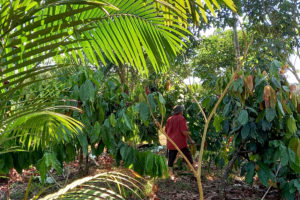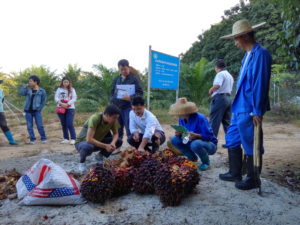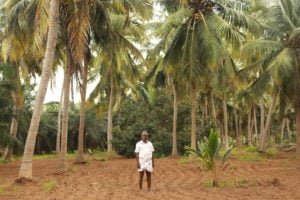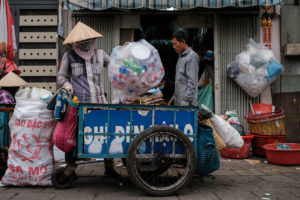On a 100-hectare plot of land nestled in Malaysia, farmers will soon begin an experiment that will turn the idea of a palm oil plantation on its head. Instead of establishing a monocrop, they will plant their oil palms alongside a lush understory of other crops and trees. They will shun chemical fertilisers in favour of organic compost, and start weeding manually to limit disturbance to the soil. “We really want to make this the way of doing agriculture in the future,” says Marco de Boer, CEO of reNature, a Dutch foundation that finances sustainable farming initiatives, and is working with the Malaysian NGO Wild Asia to deliver the project.
The method he’s referring to is regenerative agriculture, though some prefer the terms “agroecology”, “climate-smart farming” or “conservation agriculture”. While it doesn’t have a strict definition, there are two linked goals at its core: to increase biodiversity and improve soil health on farmed lands. It achieves the first through techniques such as intercropping and agroforestry, which transform farmland into mixed-use systems combining commercial crops with native shrubs and trees; and the second via methods like no-till, cover-cropping and mulching, which involves returning organic waste back to the earth.
These techniques aren’t new: indigenous cultures have been practising them for centuries. But now, proponents are calling for their application across modern monocrops – from wheat to fruit and even livestock farms – where evidence is mounting that they can deliver ecosystem services, alongside economic and social benefits.
By enriching soils, this way of farming can boost yields and simultaneously reduce the need for harmful chemical fertilisers. Diversifying plant cover can provide habitat for wildlife and make crops more resilient to pests and disease – thus requiring fewer pesticides and herbicides. Meanwhile, careful soil management could also help lock away more carbon in the ground. And a landmark study recently showed that vegetables, wheat, beef and pork produced using regenerative methods were more nutritious than food farmed conventionally.
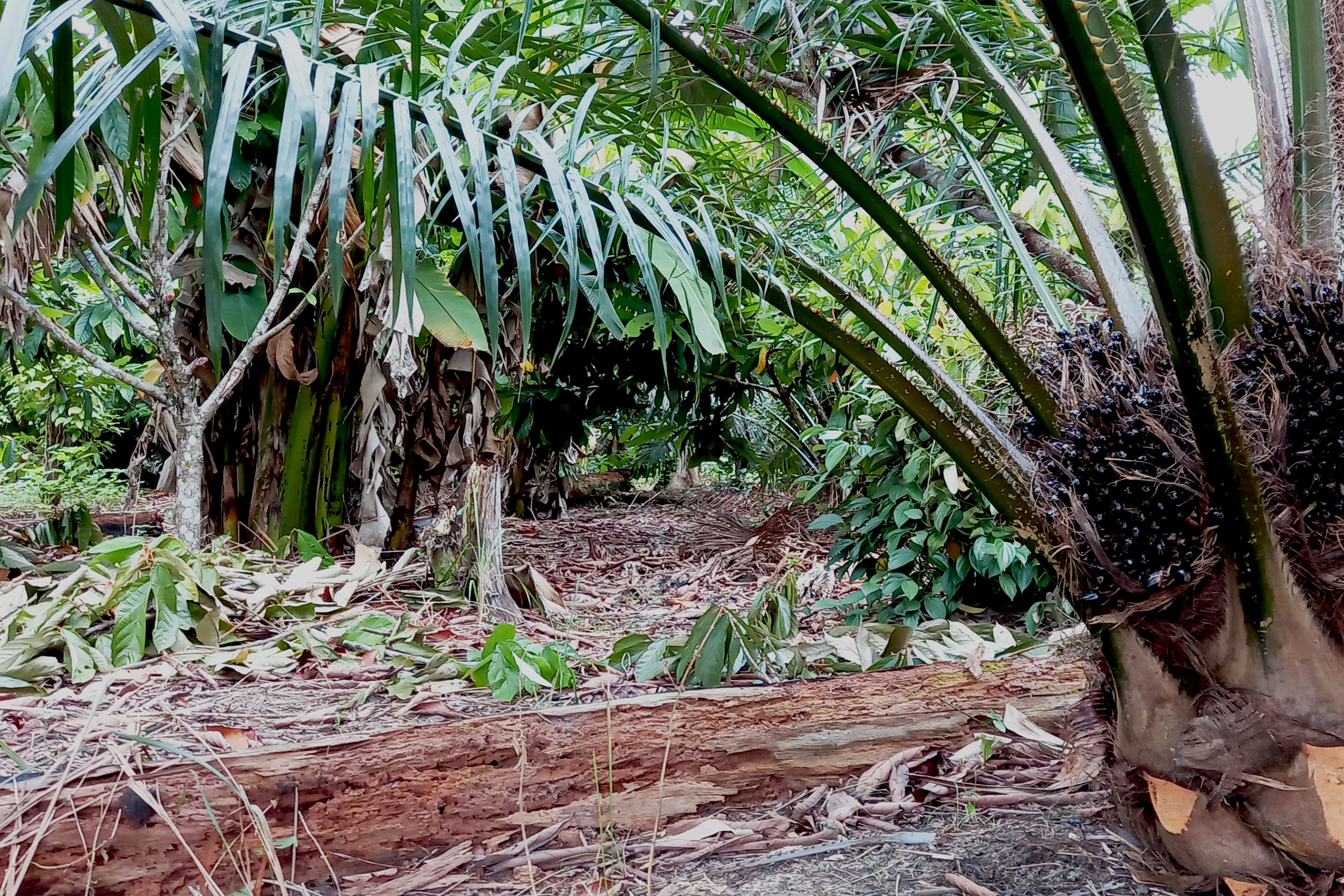
Mixed land-use could also give farmers more agency over the land: diversifying crops offers insurance against changing environmental conditions and disease, safeguards food security and can boost yields and earnings.
While regenerative agriculture is finding a foothold in the farming of many crops, palm oil is still a relatively new frontier. But precisely because of the widespread deforestation and exploitation the palm oil industry causes, proponents see it as a critical one. The question is: can regenerative methods work at scale, delivering both high yields and environmental benefits in today’s palm oil plantations?
Evidence from the field
It may still be relatively niche in palm oil, yet a handful of pioneering farmers have been testing regenerative methods for years.
In Brazil in 2008, an alliance of stakeholders launched a research project to investigate whether it would be economically and environmentally feasible to grow oil palm in mixed-use agroforestry systems. Known as SAF Dendê, the project brings together Brazilian cosmetics company Natura, a farmers’ group called the Tomé-Açú Agricultural Cooperative, the Brazilian Agricultural Research Corporation, and the World Agroforestry Centre. It now covers 18 small-scale farms over 60 hectares of the Brazilian Amazon. Across these lands, farmers have reduced herbicide and fertiliser use, helped the soil to rebuild itself, and integrated oil palms with other cash crops like passion fruit and açaí as well as native hardwood trees.

Results from ongoing research – some of which will be published later this year – show these plots hold more soil carbon and support more wildlife than conventional farms. “From soil biodiversity, to macrofauna to birdlife, the biodiversity is definitely greater in these systems than you would find in monocrops,” says Andrew Miccolis, Brazil country coordinator and lead scientist for the World Agroforestry Centre, who has been involved with the project since its inception.
Critically, these sustainable methods didn’t have an economic trade-off: over the first decade of the experiment, oil palms raised in these lusher agroforestry systems produced on average 40 kilograms more fruit per tree than their monocropped counterparts, Miccolis says. Farmers also benefit from the diversified yields, as the approach “enables adaptive management and a higher degree of flexibility, which is what farmers need for their livelihoods,” Miccolis says.
These benefits are echoed at another long-standing palm oil project in West Africa. In 2007, soap company Dr. Bronner’s established an organic and Fair Trade palm oil project in Ghana, run by its sister company Serendipalm, to ensure the sustainability of its own supply. Farmers there have built up soil nutrients by cycling organic waste back as mulch onto the land, and Serendipalm has set a standard that on newly planted sites at least 10 individual trees from other species should be included in the mix. For farmers, the greener measures have paid off: “There is evidence that you can increase annual yields by some 20%,” compared to traditional farms, says Gero Leson, vice president of special operations at Dr. Bronner’s, where he has helped the company transition to organic and Fair Trade sources for its primary ingredients.
Meanwhile, in Central Kalimantan, Indonesia, data gathered from small-scale farms that adopt greener farming methods, as laid out by the Roundtable on Sustainable Palm Oil (RSPO), suggests they enjoy higher yields. This is according to Heni Martanila, a community development manager with Indonesian non-profit Inobu, which helps farmers bring their production in line with sustainability certifications.
Yields are also mediated by factors such as the variety of oil palm that’s planted, the palm’s age, and general site maintenance, Leson says. Yet, although there’s limited research looking at the paired yield and environmental benefits of sustainable methods on palm oil farms, it does generally support the discoveries from these real-world sites: that regenerative farming methods can help boost palm oil production, while giving back to nature too.
Scaling up
But, there’s a caveat: regenerative agriculture techniques have been tested mainly on small-scale palm oil farms. These plots do generate about 40% of palm oil globally, making them a critical entry point for the approach, but the majority of palm oil comes from industrial monocrops. Scaling up regenerative agriculture into massive commercial plantations may be a bigger challenge.
Miccolis’s research with the World Agroforestry Centre has shown that in mixed-use farms, yield increases per palm, but not necessarily per hectare. That’s because more land is given to other crops and trees (there are about 100 oil palms per hectare on agroforestry farms, versus around 142 on intensive monocultures, Miccolis says.) The worry is that large-scale palm oil agroforestry could drive further expansion of plantations, if we rely on this type of farming to generate the world’s palm oil.
Miccolis explains that any potential extra land use could be offset by the incorporation of other crops onto palm oil farms if we fully embraced agroforestry across industries – which would in turn reduce the pressure of those monocultures on the land. “You might need more land to produce the same [amount of palm oil], but you’re producing several other things there as well. So the overall environmental footprint will be lower, in my view,” he says. That’s supported by modelling research showing that oil palm agroforestry could spare land by growing a greater diversity of crops in a smaller area. But more studies may be needed to understand how these trade-offs would play out at large scales.
In any case, palm oil agroforestry wouldn’t necessarily need to expand into rainforest or peatland: research shows that farmers can successfully grow oil palms in already degraded lands such as former pasture. If cultivated using regenerative methods, palm oil farming could also then bring biodiversity and increased carbon capture to depleted soils, Miccolis adds.
Another challenge is how to bring regenerative farming onto established plantations. Here in fact, Miccolis reckons there could be an opportunity. Oil palm productivity declines after about 25 years, when trees are uprooted and replaced with palm seedlings. This changeover offers a chance to wipe the slate clean and begin farming regeneratively across large swathes of land. Miccolis and colleagues at the World Agroforestry Centre are now looking at how to “incentivise companies when they are replanting, to be more sustainable and to introduce more biodiversity,” he says.
Farmers may also find they have an economic incentive. By the end of their productive lifespans, conventionally grown oil palms can degrade soil, locking farmers into a cycle of dependence on expensive chemical inputs to enrich the soil for successive plantings. Switching to regenerative measures that build up soil health could break them out of this costly loop.
Perhaps the biggest obstacle to the spread of regenerative agriculture is the human element: farmers must be willing to adopt it, both Leson and Miccolis say. Leson cautions that it is even difficult to convince small-scale farmers to embrace regenerative methods, when the potential benefits of diversified income and food security are clear. “The rewards are sweet,” he says, but “setting it up is clearly more challenging than having a simple monocrop.” Owners of industrial palm oil plantations will only be more reluctant, since they’re already reaping huge profits by farming a single crop at scale. “Mixing tree species is not a very attractive concept for people who plant palm to make money,” Leson says.

In this and many other ways, palm oil distills the challenges of modern industrial agriculture, wherein huge profits are built on environmental destruction. So, what is required to change it? Miccolis thinks nothing short of a seismic cultural transformation in the industry – “a real shift in their business model, and how they make money from that land.”
Unpicking monoculture swathes and transforming them into mixed-use agroforestry would require a huge leap. But crucially for farmers it could also unlock new revenue streams. Diversified crops could provide new income and be a buffer in changing markets; meanwhile sustainably grown palm oil could be sold at a premium. The growing carbon market – which is already tapping into the potential of agroforestry – could provide new credit-selling opportunities for farmers whose methods can be proven to lock more carbon in the soil.
These could help shift the farming paradigm towards what proponents of regenerative agriculture believe it should be: a system that makes profits by incorporating nature – fostering biodiversity, reducing pollution and capturing carbon – instead of by excluding it.
The outlook
For palm oil, that future still seems far off. Regenerative agriculture to produce this commodity is currently confined to just a handful of small farms. Because of the unique challenges of integrating it into palm oil systems, it’s likely to be some time before we see trials on large industrial plantations, Leson believes. But buy-in from large companies willing to take a leap could send the right messages to the industry and pave the way forward.
Inobu is now working towards incorporating regenerative agriculture principles across more of its projects, but until recently Martanila says that this principle hasn’t been commonplace in her work with thousands of small-scale farms in Indonesia.
There are ‘shades’ of regenerative agricultureGero Leson, vice president of special operations at Dr. Bronner’s
Leson thinks one way to increase uptake on farms is to break it down into its component parts. “There are ‘shades’ of regenerative,” he says, explaining that not every farm has to transition to full agroforestry to make a difference. For instance, simply cycling agricultural biomass back into the ground to build up soil health and capture carbon, could be a powerful starting point on industrial monocrops, and may even be easier to accomplish on large farms with more labour and machinery, he says.
Otherwise, certification could be a tool to encourage wider adoption of regenerative agriculture in the long-term – and there is now one in development. In 2017, Dr. Bronner’s, along with several other companies, farmers and researchers established Regenerative Organic Certified (ROC), a high bar for what this type of farming should look like. Still in its infancy, Leson hopes the ROC standard will gain a foothold in the palm oil industry. ROC is joined by other efforts such as Palm Done Right, a standard developed by the company Natural Habitats in 2013 to endorse palm oil grown using organic and Fair Trade practices.
Meanwhile, pioneering farmers will continue testing regenerative agriculture out in the field. Back in Malaysia, if the experimental agroforestry plot delivers economic and environmental benefits, it could be expanded to hundreds of small-scale palm oil farms across the region, putting these measures into practice across several thousand hectares more. Progress may be slow and piecemeal, but Leson says, “I have this feeling that the concept of regenerative agriculture is going to grow.”
This article is part of our ongoing series on palm oil. Explore the series to date here.
